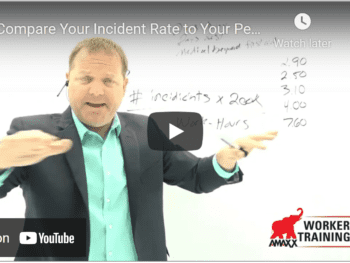I enjoy seeing various claims professionals discuss file dynamics. Due to jurisdictional statutes, a case may be accepted in one state and a total denial in a different state.
Click Link to Access Free PDF Download
“4-Step Sequence For Effective Employee Screening, Hiring, & Placement”
The establishment of a safety defense on a claim is always a good discussion. It seems like no matter what the state statute, if a worker clearly violates an established safety protocol there is a good angle for a denial.
Safety Rule Book Needs to Be Clear and Consistently Enforced
In my mind, denial of a case on a safety violation poses a careful orchestration of many facts. First of all you need to prove the violation. Typically the safety handbook has to be the main rule book, and violations of the rules set in the book lead to swift and calculated discipline. Accumulation of a number of disciplinary actions will result in termination or suspension. This has to be very clear, very defined, and very enforced across the board. The same rules apply to everyone at the employer.
The Injury Scene Has To Be Preserved
Next the machine or violation has to be preserved. Pics and video of the scene post-injury have to be secured as soon as possible. Cell phone video cameras now are so easy to use, it’s the greatest way to secure evidence on a scene.
Statements Need to Be Obtained and Recorded
The machine has to be roped off and nothing should be touched until your carrier representatives get there and do their jobs. Witnesses need to be interviewed, and it should be video-recorded with your phone if applicable. The statement of the injured worker also needs to be obtained as soon as possible and video-recorded for preservation.
The denials on these cases can go on for months if not years in litigation. Recording and then transcribing the statements keep the stories the same, just in case your witnesses need to testify later on in the case.
A Case to Ponder: Compensable or Not?
Here is a case to ponder: A worker has worked this same machine for a year. The machine roller-feeds 5’x5’ steel sheets to a massive pin roller that continually flattens the steel several times before reaching the end of the machine. The worker then picks up the sheet and places it in a big cart. Think about a pile of dough you flatten out to make pizza dough. Same type of situation at this job station only with steel sheets instead of dough.
This worker noticed one of the rollers was not working properly. He was going to fix it on the fly, instead of following the documented protocol for machine maintenance. This includes lock out/tag out of the machine, notifying the maintenance supervisor on shift, and also completing a form detailing the repair. When the worker went to grab the roller, his glove caught in another roller and he crushed his middle finger. The damage was too bad to repair, and the surgeon had to fully amputate the middle finger on his dominant hand.
Clearly, this worker knew better than to repair the machine without following the rules. The adjuster did some digging and found out that the worker had been disciplined on this machine before 3 separate times, and this last violation that occurred with this injury was the last strike and he was terminated.
This case is a clear example of what can happen when you do not follow safety protocols and procedures.
After the investigation and adjuster roundtable with the employer, this case was denied as a direct safety violation. Litigation is just starting in this case and I am curious to see how it turns out.
The employee stance looks like they will say the machine was not guarded properly, and that he requested guarding several times to the employer who ignored his requests. Based on the pictures, the worker is indeed correct—there is clear access to the large rollers and there is no guarding or process visible.
However is that going to be enough for the plaintiff to win this case? Or will the Judge side with the carrier, and be under the impression that this case is just another example of how cutting a safety corner can affect a worker for the rest of their life?
Author Michael B. Stack, Principal, COMPClub, Amaxx Work Comp Solutions. He is an expert in employer communication systems and helps employers reduce their workers comp costs by 20% to 50%. He resides in the Boston area and works as a Qualified Loss Management Program provider working with high experience modification factor companies in the Massachusetts State Risk Pool. He is co-author of the #1 selling book on cost containment, Your Ultimate Guide To Mastering Workers Comp Costs www.reduceyourworkerscomp.com, and Founder of the interactive Workers’ Comp Training platform COMPClub. Contact: [email protected].
©2015 Amaxx LLC. All rights reserved under International Copyright Law.
SALES TO PAY FOR ACCIDENTS CALCULATOR: http://reduceyourworkerscomp.com/sales-to-pay-for-accidents-calculator/
WC GROUP: http://www.linkedin.com/groups?homeNewMember=&gid=1922050/
Do not use this information without independent verification. All state laws vary. You should consult with your insurance broker, attorney, or qualified professional.
















A Case to Ponder: The plaintiff counsel will also likely look for any production quotas, written or perceived to strengthen a case for furthering the employers business interests. I believe if anyone had ever received any corrective actions for low production, the safety violations will be moot on the issue of WC.
Very god info , thanks